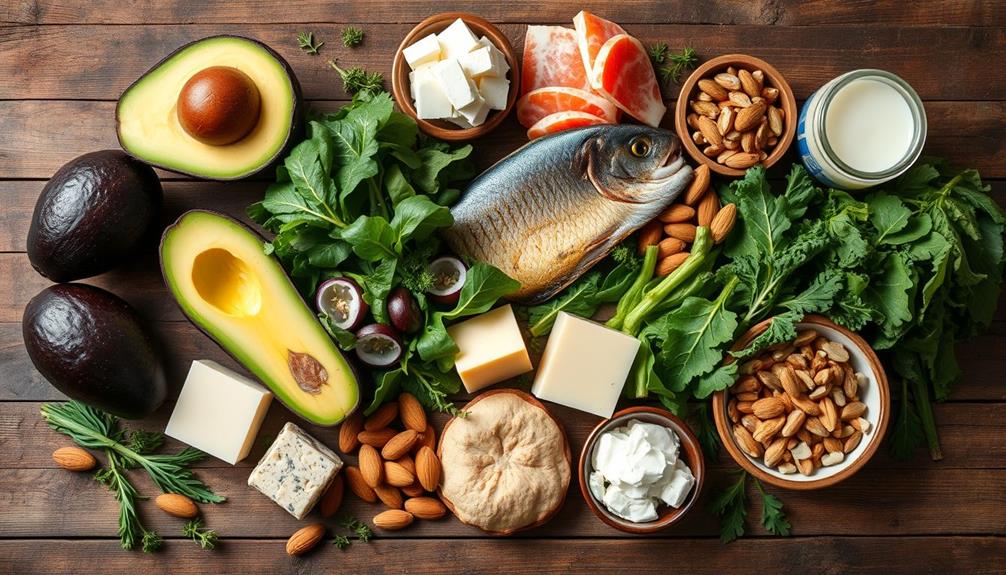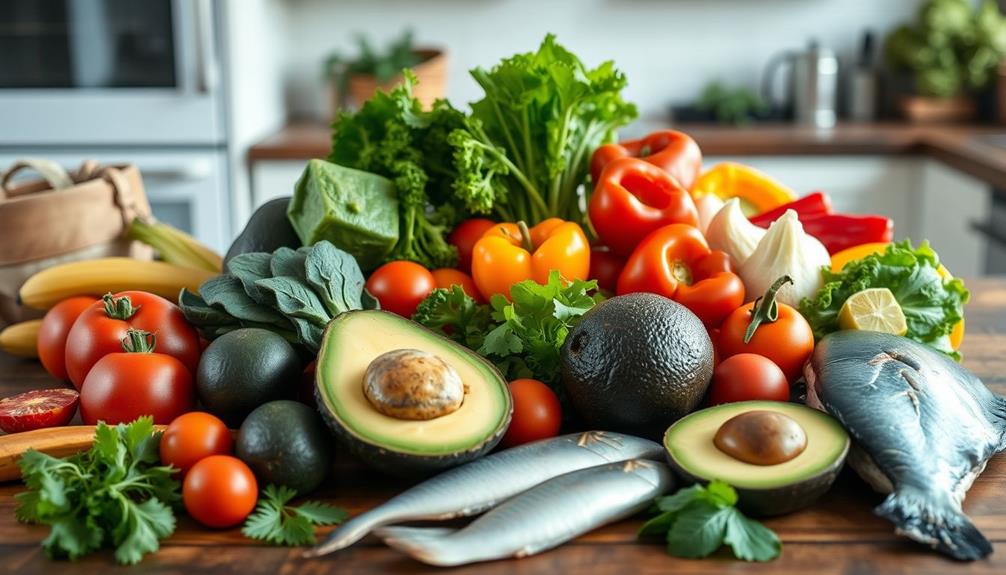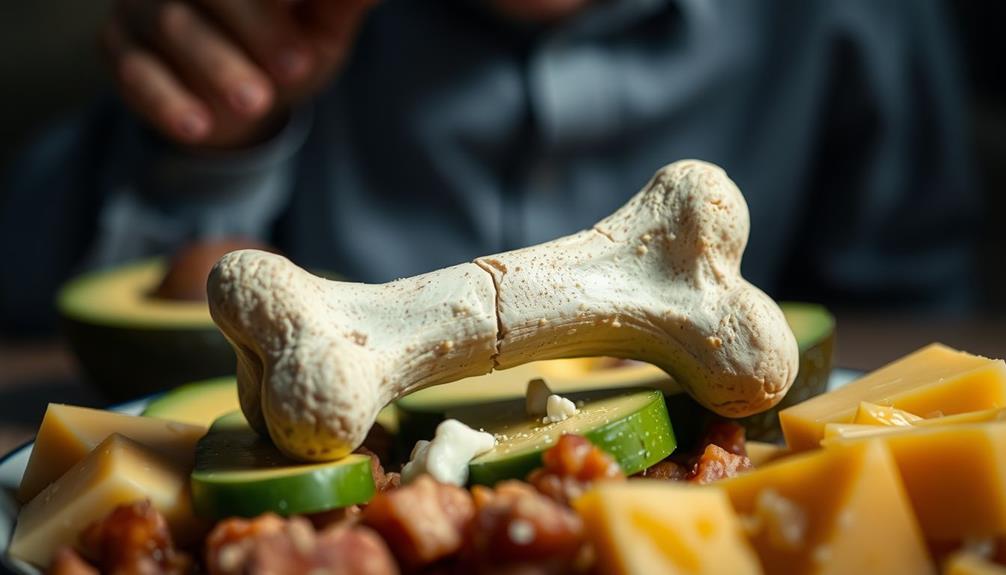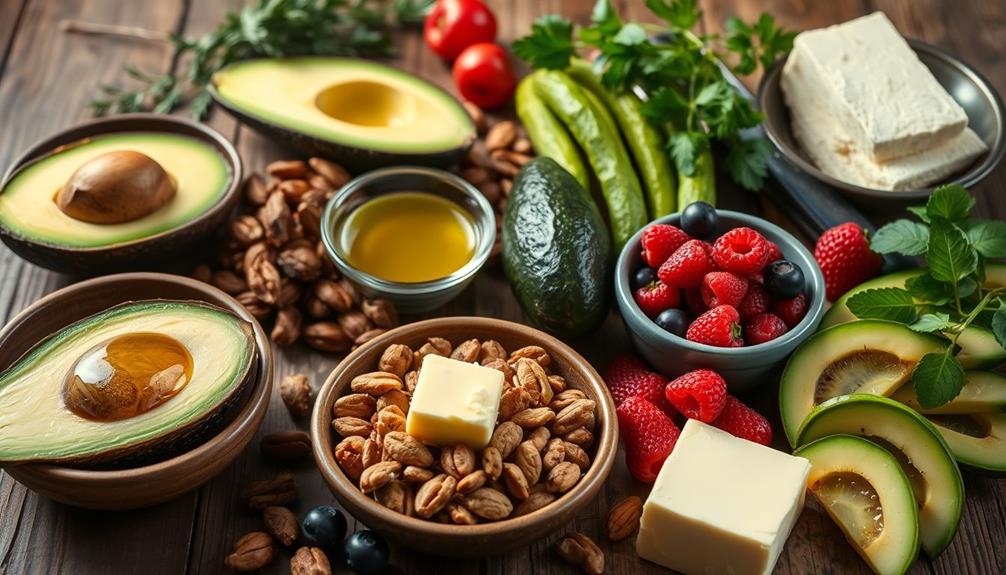To start a keto diet for weight loss, you'll need to cut carbs to under 50 grams daily and ramp up your fat intake. Aim for 70-80% of your calories from healthy fats like avocados and olive oil, while keeping protein moderate at 15-25%. This shift helps your body enter ketosis, burning fat for energy. You might experience some initial side effects like fatigue or headaches, but these typically pass. Meal prep is key for success, so keep keto-friendly snacks on hand. Stick with it, and you'll notice weight loss and improved mental clarity as you go. There's more to explore on this journey.
Key Takeaways
- Follow a strict macronutrient ratio of 70-80% fat, 15-25% protein, and 5-10% carbs to achieve ketosis.
- Incorporate high-fat and low-carb foods like avocados, nuts, and leafy greens into your meals.
- Track your daily food intake and macronutrient ratios using a food diary or app for effective weight loss.
- Stay hydrated to combat potential "keto flu" symptoms during the initial adaptation phase.
- Monitor your progress by weighing weekly and measuring ketone levels to confirm you are in ketosis.
Understanding the Ketogenic Diet

When it comes to understanding the ketogenic diet, you're diving into a low-carb, high-fat eating plan designed to shift your body into a state of ketosis. This metabolic state occurs when you drastically reduce your carbohydrate intake—typically to less than 50 grams a day—allowing your body to burn fat for fuel instead of glucose.
By consuming around 70-80% fat, 15-25% protein, and only 5-10% carbohydrates, you encourage the production of ketone bodies in your liver, which serve as an alternative energy source for both your brain and body. Incorporating effective strategies for weight loss can further enhance your results while on this diet.
Transitioning into ketosis usually takes about 3-4 days of strict adherence to the diet, and during this time, you might experience signs like bad breath, increased thirst, or reduced hunger. These symptoms indicate that your body is adjusting to this high-fat diet.
Research shows that individuals on the ketogenic diet often achieve weight loss more effectively than those on a low-fat diet, losing an average of 2 pounds more in the initial months.
With its potential health benefits, understanding the ketogenic diet can pave the way for effective weight loss and improved overall well-being.
Key Food Choices for Keto

To successfully navigate the ketogenic diet, making the right food choices is essential. Focus on incorporating high-fat foods like avocados, nuts, seeds, olive oil, and fatty fish to meet the macronutrient ratio of approximately 70-80% fat. These healthy fats are important for energy and overall well-being while you pursue weight loss.
Additionally, consider including foods with antioxidant properties, as they can support your health during the diet, such as a rich source of antioxidants found in certain vegetables.
Next, add low-carb vegetables such as leafy greens, broccoli, and cauliflower to your meals. They provide important nutrients while keeping your carbohydrate intake low, which is vital for maintaining ketosis. Aim to consume fewer than 50 grams of carbs per day by limiting or avoiding grains, sugars, starchy vegetables, and most fruits.
When it comes to protein sources, choose wisely. Favor moderate amounts of meats, poultry, eggs, and unprocessed dairy to guarantee you're getting enough protein without compromising the diet's fat-focused nature.
Lastly, be vigilant about hidden carbs in processed foods and condiments. Always check food labels to avoid unintentional carbohydrate consumption, which can disrupt ketosis.
Health Benefits of Keto

When you follow a ketogenic diet, you may notice impressive weight loss efficiency right from the start.
This diet can also lead to reduced cravings, making it easier to stick to your nutritional goals.
It can also improve your blood sugar levels, which is especially beneficial if you're dealing with insulin sensitivity issues.
Plus, many people report enhanced mental clarity, making it easier to stay focused throughout the day.
For those looking for additional health benefits, incorporating natural remedies alongside conventional methods could further enhance your wellness journey.
Weight Loss Efficiency
The ketogenic diet stands out for its impressive weight loss efficiency, particularly when compared to traditional low-fat diets. Studies show that participants on a strict low-carb regimen lost an average of 2 pounds more over a 3-6 month period than those following a low-fat approach. This is largely due to significant fat loss, especially in visceral fat, which is linked to various metabolic diseases.
Here's a quick comparison of weight loss outcomes:
| Keto Diet | Low-Fat Diet |
|---|---|
| Greater fat loss | Lower fat loss |
| Improved insulin sensitivity | Moderate insulin sensitivity |
| Enhanced appetite suppression | Increased hunger |
With a ketogenic diet, you may experience better metabolic health, allowing your body to utilize fat for energy more effectively. This improved insulin sensitivity helps reduce fat storage, making it a powerful option for those managing their body weight. Plus, many participants report feeling less hungry, which aids in maintaining a caloric deficit essential for effective weight loss. Embracing this low-carb regimen could be the key to achieving your weight loss goals.
Improved Blood Sugar
Improving blood sugar levels is one of the standout benefits of the ketogenic diet, especially for those managing conditions like type 2 diabetes. Studies have shown that about 60% of participants with type 2 diabetes achieve better glucose control after just 16 weeks on this diet.
By considerably reducing carbohydrate intake, the ketogenic diet lowers insulin levels, which helps combat insulin resistance and promotes fat burning. This is particularly important for individuals who may also struggle with emotional dysregulation, as seen in conditions like Borderline Personality Disorder, where managing stress and mood can complicate dietary adherence.
Research indicates that individuals on this diet experience an average reduction in HbA1c levels by 1% to 2%, reflecting improved long-term blood sugar control. Additionally, the ketogenic diet has been found to lead to greater reductions in fasting blood glucose levels compared to low-fat diets, highlighting its effectiveness in managing diabetes.
Another advantage is the reported reduced hunger and cravings among participants, which can enhance adherence to the diet. This, in turn, contributes to better metabolic health and more stable blood sugar regulation.
Enhanced Mental Clarity
Enhanced mental clarity is one of the remarkable benefits you can experience on a ketogenic diet. As your body enters ketosis, it produces ketones, which serve as an efficient energy source for your brain. This shift can greatly enhance cognitive function, leading to improved attention and focus. AI-Powered Virtual Reality in E-Learning indicates that research shows individuals on a ketogenic diet may see up to a 20% increase in cognitive performance compared to those consuming higher carbohydrate diets.
By stabilizing blood sugar levels, ketosis helps prevent energy spikes and crashes that can result in brain fog and hinder concentration. Many followers of the ketogenic diet report reduced brain fog and improved mood stability, which can boost your productivity and mental agility.
Furthermore, the anti-inflammatory properties of ketones may protect your brain health, lowering the risk of neurodegenerative diseases and supporting long-term cognitive function.
Common Side Effects

Starting a ketogenic diet can sometimes feel like a challenging journey, especially when you encounter common side effects known as "keto flu." During the initial adaptation phase, you might experience fatigue, headache, nausea, dizziness, and irritability as your body adjusts to burning fat for fuel instead of carbohydrates.
Many dieters also report digestive issues, such as constipation, diarrhea, or stomach cramps, due to the significant reduction in carb intake and changes in fiber consumption. It's also important to track your progress and set specific savings goals for maintaining your health and wellness during this shift.
As you enter ketosis, you may notice fruity-smelling urine and bad breath, which are indicators of ketone bodies produced during fat metabolism.
It's vital to remember that the initial weight loss you experience is primarily water weight, leading to feelings of fatigue and dehydration as glycogen stores deplete. While these side effects are generally temporary and can subside within a few days to weeks, it's important to stay hydrated.
If you find that your symptoms persist or worsen, consulting a healthcare professional is advisable. They can provide guidance to help you navigate these side effects and make sure your keto journey is as safe and effective as possible.
Meal Planning Strategies

Effective meal planning is essential for successfully managing a ketogenic diet. To maximize your weight loss efforts, focus on high-fat foods and carefully curate your meal plan. Incorporating strategies such as diversifying your food sources can also enhance your meal variety, just as investment strategies in precious metals can optimize your financial portfolio.
Here are some strategies to help you stay on track:
- Prioritize high-fat foods: Include avocados, nuts, seeds, and fatty fish to guarantee 70-80% of your daily caloric intake comes from fats while keeping your carbohydrate intake below 50 grams.
- Utilize a meal prep strategy: Prepare and portion out keto-friendly meals for the week. This makes it easier to stick to your diet during busy days and reduces the temptation to indulge in high-carb options.
- Incorporate low-carb vegetables: Add fiber and essential nutrients by including spinach, broccoli, and zucchini in your meals, all while staying within your carb limits.
- Keep keto snacks handy: Stock up on cheese, hard-boiled eggs, and nut butter to manage hunger between meals and prevent cravings for high-carb foods.
Don't forget to track your macronutrients using a food diary or app to adjust portion sizes and maintain the right balance for effective weight loss.
Long-term Sustainability

Maintaining a ketogenic diet over the long term requires thoughtful strategies that go beyond meal planning. To achieve long-term weight loss, you'll need to focus on incorporating a variety of nutrient-dense, low-carb foods. Think avocados, leafy greens, and nuts to prevent nutrient deficiencies.
Additionally, understanding the importance of emotional and psychological growth can help you stay committed to your dietary goals, as key domains of development influence behavior and habits. Regularly tracking your macronutrient intake is essential; aim for a balance of 70-80% fat, 15-25% protein, and 5-10% carbohydrates to enhance adherence and effectiveness.
Consider gradually reintroducing carbs after an initial strict keto phase. This approach can help you maintain weight reduction while avoiding discomfort from sudden dietary changes. Crafting a personalized meal plan that includes your favorite keto-friendly foods makes the diet more enjoyable and manageable, increasing the likelihood of sticking with it.
Engaging with support groups or communities can also provide motivation and accountability. Surrounding yourself with others who share your goals can greatly boost your commitment to the keto diet.
With the right strategies in place, you'll find that long-term sustainability on the keto diet can be achievable and rewarding.
Monitoring Your Progress
As you navigate your ketogenic journey, keeping track of your progress is vital to achieving your weight loss goals. Monitoring various aspects helps guarantee your ketogenic diet is effective and tailored to your needs. Here are four key areas to focus on:
1. Weight Tracking: Weigh yourself weekly to monitor changes and evaluate how well the ketogenic diet promotes fat loss over time.
Additionally, utilizing gentle stretching techniques can help improve your physical comfort as you progress.
2. Food Diary: Use a food diary or mobile app to log your daily intake, making certain you adhere to the recommended macronutrient ratio—70-80% fat, 15-25% protein, and 5-10% carbohydrates.
3. Ketone Levels: Measure your ketone levels with urine strips, breath analyzers, or blood meters. This confirms you're in ketosis, vital for maximizing fat burning.
4. Body Measurements: Don't just rely on weight; track your body measurements, like waist and hip circumference, for a broader view of your progress, especially during early fluctuations due to water weight.
Additionally, keep an eye on your energy levels and overall well-being, noting any improvements in hunger control and mental clarity.
Frequently Asked Questions
How Do I Start Losing Weight on Keto?
To start losing weight on keto, calculate your macronutrient needs, eliminate high-carb foods, and focus on healthy fats. Plan meals ahead, monitor your ketone levels, and stay hydrated for the best results.
What Are the Basic Rules for Keto?
Think of keto like a high-performance sports car; you need the right fuel. Stick to low carbs, embrace healthy fats, and monitor your ketone levels—it's essential for driving your body into ketosis effectively.
How Do I Start My Keto Diet for the First Time?
To start your keto diet, calculate your macronutrient ratios, stock up on keto-friendly foods, stay hydrated, plan meals ahead, and monitor your ketone levels. You'll adapt quickly and enjoy the benefits of ketosis.
How Much Weight Can You Lose in 1 Week on Keto?
In the first week on keto, you could shed 1 to 10 pounds, like a snake shedding its skin. Most of this is water weight, but your body's gearing up for more sustainable fat loss ahead.
Conclusion
Starting on a keto diet can be a transformative journey for your weight loss goals. Remember, "slow and steady wins the race." By understanding the diet, making smart food choices, and planning meals, you'll set yourself up for success. While challenges may arise, staying committed will help you reap the benefits. So, embrace the process, track your progress, and watch as your hard work pays off. You've got this!









